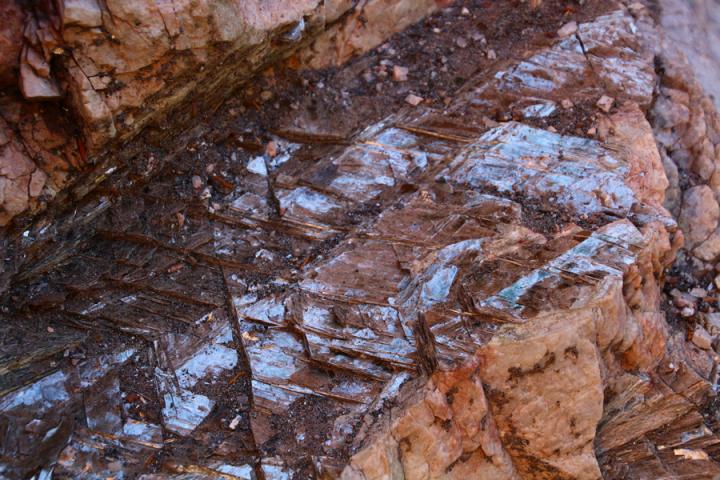Mica provides clue to how water transports minerals

Researchers at Argonne looked at the dynamics of the transport of certain elements -- especially rubidium -- at the interface between water and mica, a flat transparent mineral pictured above. Credit: Beth Harvey/Shutterstock
In a new study from the U.S. Department of Energy's (DOE) Argonne National Laboratory, in collaboration with the University of Illinois and Chicago and the University of Delaware, chemists have been able to look at the interface between water and muscovite mica, a flat mineral commonly found in granite, soils and many sediments. In particular, the researchers looked at the capture and release of rubidium – a metal closely related to but more easily singled out than common elements like potassium and sodium.
Essentially, it's like looking for a goldfinch in a tree, and using a technique that only shows you where yellow things are.”
In the experiment, the researchers flowed a rubidium-containing solution over the mica, which caused rubidium atoms to replace the potassium that occurs naturally near the surface of the mica. Then the rubidium solution was replaced for one containing sodium, which in turn replaced the rubidium atoms.
According to Argonne chemist Sang Soo Lee, who led the study, the dynamics of the ion transport were largely controlled by electrostatic properties at the interface between the mica and the water. Essentially, the rubidium atoms “clung” to the mica's surface similarly to how lint clings to clothing. The strength of the clinging behavior was determined mainly by how many water molecules were in between the mica's surface and the rubidium – the fewer water molecules, the tighter the cling.
Lee and his Argonne colleague, chemist Paul Fenter, used Argonne's Advanced Photon Source, a DOE Office of Science User Facility, to observe the activity of the rubidium using a technique called resonant anomalous X-ray reflectivity. This technique allows scientists to probe the position of a single element at an interface.
“Essentially, it's like looking for a goldfinch in a tree, and using a technique that only shows you where yellow things are,” Fenter said.
By using the technique, the researchers were able to condense the timeframe it takes to measure the signal from the data. “Normally these data take hours to measure, but now we can have a time resolution of one or two seconds,” Fenter said.
Having a picture of the real-time dynamics of these kinds of interfaces give scientists a new view of how ions sense surfaces energetically. “If you think of our experiments like watching planes at an airport, then previously we were able to only know how many Boeings or Cessnas there were,” Lee said. “Now, we have a way to watch the planes actually take off and land.”
###
The research was funded by DOE's Office of Science (Office of Basic Energy Sciences).
A paper based on the research, “Real-time observations of cation exchange kinetics and dynamics at the muscovite-water interface,” was published in Nature Communications on June 9.
Argonne National Laboratory seeks solutions to pressing national problems in science and technology. The nation's first national laboratory, Argonne conducts leading-edge basic and applied scientific research in virtually every scientific discipline. Argonne researchers work closely with researchers from hundreds of companies, universities, and federal, state and municipal agencies to help them solve their specific problems, advance America's scientific leadership and prepare the nation for a better future. With employees from more than 60 nations, Argonne is managed by UChicago Argonne, LLC for the U.S. Department of Energy's Office of Science.
The U.S. Department of Energy's Office of Science is the single largest supporter of basic research in the physical sciences in the United States and is working to address some of the most pressing challenges of our time. For more information, visit the Office of Science website.
Media Contact
All latest news from the category: Life Sciences and Chemistry
Articles and reports from the Life Sciences and chemistry area deal with applied and basic research into modern biology, chemistry and human medicine.
Valuable information can be found on a range of life sciences fields including bacteriology, biochemistry, bionics, bioinformatics, biophysics, biotechnology, genetics, geobotany, human biology, marine biology, microbiology, molecular biology, cellular biology, zoology, bioinorganic chemistry, microchemistry and environmental chemistry.
Newest articles

A ‘language’ for ML models to predict nanopore properties
A large number of 2D materials like graphene can have nanopores – small holes formed by missing atoms through which foreign substances can pass. The properties of these nanopores dictate many…

Clinically validated, wearable ultrasound patch
… for continuous blood pressure monitoring. A team of researchers at the University of California San Diego has developed a new and improved wearable ultrasound patch for continuous and noninvasive…

A new puzzle piece for string theory research
Dr. Ksenia Fedosova from the Cluster of Excellence Mathematics Münster, along with an international research team, has proven a conjecture in string theory that physicists had proposed regarding certain equations….



